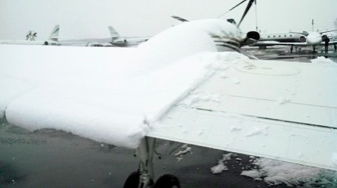How has your experience been in cold weather operations? Most of us have not had the chance to train in these situations or become aware of the various pitfalls and preparations needed to avoid issues. Among the most seasoned pilots out there, this may be common knowledge however, it may help introduce some of the newcomers to winter operations.
 As we all know, airfoils love cold and dense air masse but when mixed with one or more of the many versions of H2O, not so much. Engines, propellers, brakes, instruments and avionics simply despise the very condition that provides us with the great performance we inherit in the winter months.
As we all know, airfoils love cold and dense air masse but when mixed with one or more of the many versions of H2O, not so much. Engines, propellers, brakes, instruments and avionics simply despise the very condition that provides us with the great performance we inherit in the winter months.
In this two part series, I’ll be running through a few items to keep in mind during winter weather on airframes, engines, propellers and brakes.
Airframes:
One of the many important variables we face as pilots are freezing temperatures, dew points and the adherence of the aquatic to our airplanes. These items are not so much a factor once airborne with those big, beefy wings, as long as you don’t drive around in it for an hour or two. It’s really more of a headache in the preflight planning period of our trips (alliteration intended). Frost? Frost is easy; that’s nothing a little direct sunlight, heated hangar, or isopropyl alcohol in a bug sprayer can’t solve. But snow, sleet and freezing rain… there are just so many variables to consider. The biggest of which is, “is the subzero precipitation still precipitating?” For example, if it’s a dry snow, it may be better to just sweep off the majority just before departure versus moving the airplane into a heated hangar. While the heated hangar will prove effective in melting the snow, it can also warm the airframe surface to above freezing temperatures. Once you evacuate that warm atmosphere, the still falling snow can melt and then refreeze in the form of clear ice, the bulk of which will be on unprotected surfaces. I have also had success in removing snow with a common leaf blower believe it or not! I have yet to find any options outside of professionally applied deicing fluids to counter freezing rain, though I have been fortunate enough to avoid those situations all together by just postponing or canceling the trip. Sometimes, it’s better to let Mother Nature win.
Engines:
 Realistically, I could have left this one out because they actually like the cold, once they warm up; however there is one item I want to address. Most of you have probably experienced the following phenomena early on in your career and as a result quickly contacted your most trusted mechanic for assurance that nothing was erroneous with your turbines. The phenomena I’m referring to is the profuse amount of white smoke that billows from your exhaust stacks most every time you startup and shutdown in temperatures below 20 degrees Fahrenheit (-6.6 C), thus causing your passengers to move about frantically wondering if something is on fire! And if you’re like me, your response is, “it’s just really cold outside”, mainly because I don’t have time to thoroughly explain to them this particular circumstance. In fact it’s a common trait, not only with turbine engines but also diesel engines as well. The fuel is too cold and dense to atomize and ignite efficiently and thus creates an effect not dissimilar to the smoke airshow pilots produce by introducing used oil onto their searing hot exhausts. This event is not damaging to our engines, unless the smoke continues long after startup. Then you may have a problem.
Realistically, I could have left this one out because they actually like the cold, once they warm up; however there is one item I want to address. Most of you have probably experienced the following phenomena early on in your career and as a result quickly contacted your most trusted mechanic for assurance that nothing was erroneous with your turbines. The phenomena I’m referring to is the profuse amount of white smoke that billows from your exhaust stacks most every time you startup and shutdown in temperatures below 20 degrees Fahrenheit (-6.6 C), thus causing your passengers to move about frantically wondering if something is on fire! And if you’re like me, your response is, “it’s just really cold outside”, mainly because I don’t have time to thoroughly explain to them this particular circumstance. In fact it’s a common trait, not only with turbine engines but also diesel engines as well. The fuel is too cold and dense to atomize and ignite efficiently and thus creates an effect not dissimilar to the smoke airshow pilots produce by introducing used oil onto their searing hot exhausts. This event is not damaging to our engines, unless the smoke continues long after startup. Then you may have a problem.
In part two, I’ll be running through propellers and brakes. Stay tuned!
[divider]
About the Author: J.D. Marshall
J.D. Marshall is an ATP, CFI, and A&P and has been flying and maintaining aircraft for twenty years. For the last ten years, he has flown in the charter and corporate aviation environment, acquiring over 6000 flight hours of experience in more than 110 different aircraft consisting of 45 different types, taking off and landing at over 400 different airports throughout the United States, Canada and the Caribbean. He has experience in the Beechcraft King Air C90 A/B, E90, 200, B200, 300, and 350.

![KingAir – King of the Cold (Part 1) [Op-Ed] KingAir – King of the Cold (Part 1) [Op-Ed]](https://cdn11.bigcommerce.com/s-bng8bbzq86/images/stencil/160w/uploaded_images/snowka.jpeg?t=1665687879)
